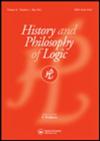‘Everything True Will Be False’: Paul of Venice and a Medieval Yablo Paradox
IF 0.5
3区 哲学
Q3 HISTORY & PHILOSOPHY OF SCIENCE
引用次数: 0
Abstract
In his Quadratura, Paul of Venice considers a sophism involving time and tense which appears to show that there is a valid inference which is also invalid. Consider this inference concerning some proposition A : A will signify only that everything true will be false, so A will be false. Call this inference B . A and B are the basis of an insoluble-that is, a Liar-like paradox. Like the sequence of statements in Yablo's paradox, B looks ahead to a moment when A will be false, yet that moment may never come. In the Quadratura, Paul follows the solution to insolubles found in the collection of elementary treatises known as the Logica Oxoniensis, which posits an implicit assertion of its own truth in insolubles like B . However, in the treatise on insolubles in his Logica Magna, Paul develops and endorses a different solution that takes insolubles at face value. We consider how both types of solution apply to A and B : on both, B is valid. But on one, B has true premises and false conclusion, and contradictories can be false together; on the other (following the Logica Oxoniensis), the counterexample is rejected.“一切真的都会是假的”:威尼斯的保罗与中世纪的亚布洛悖论
在他的Quadratura中,威尼斯的保罗考虑了一个涉及时间和时态的诡辩,这似乎表明有一个有效的推理也是无效的。考虑这个关于命题A的推论:A只表示一切真都是假的,所以A是假的。称这个推论为B。A和B是一个无法解决的问题的基础,也就是说,一个类似谎言的悖论。就像Yablo悖论中的语句序列一样,B期待着a为假的时刻,但这个时刻可能永远不会到来。在《四分体》中,保罗遵循了在初级论文集《逻辑学》(Logica Oxoniensis)中发现的不溶物的解,它在B等不溶物中隐含地断言了自己的真理。然而,在他的《大逻辑》中关于不溶物的论述中,保罗发展并认可了一种不同的解决方案,这种解决方案从表面上看待不溶物。我们考虑两种类型的解如何适用于A和B:在两者上,B都有效。但是在第一种情况下,B有真前提和假结论,矛盾体可以同时为假;另一方面(根据《牛津逻辑学》),反例被拒绝。
本文章由计算机程序翻译,如有差异,请以英文原文为准。
求助全文
约1分钟内获得全文
求助全文
来源期刊

History and Philosophy of Logic
综合性期刊-科学史与科学哲学
CiteScore
0.80
自引率
0.00%
发文量
24
审稿时长
>12 weeks
期刊介绍:
History and Philosophy of Logic contains articles, notes and book reviews dealing with the history and philosophy of logic. ’Logic’ is understood to be any volume of knowledge which was regarded as logic at the time in question. ’History’ refers back to ancient times and also to work in this century; however, the Editor will not accept articles, including review articles, on very recent work on a topic. ’Philosophy’ refers to broad and general questions: specialist articles which are now classed as ’philosophical logic’ will not be published.
The Editor will consider articles on the relationship between logic and other branches of knowledge, but the component of logic must be substantial. Topics with no temporal specification are to be interpreted both historically and philosophically. Each topic includes its own metalogic where appropriate.
 求助内容:
求助内容: 应助结果提醒方式:
应助结果提醒方式:


